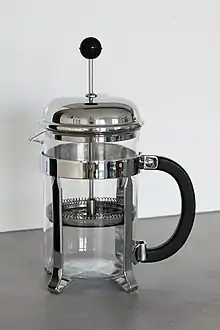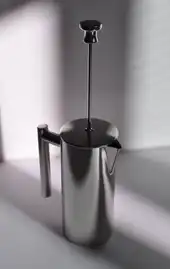French press
A French press, also known as a cafetière, cafetière à piston, caffettiera a stantuffo, press pot, coffee press, or coffee plunger, is a coffee brewing device, although it can also be used for other tasks. The earliest known device was patented in 1852 in France by Jacques-Victor Delforge and Henri-Otto Mayer.

Name
In English, the device is known in North America as a French press or coffee press; in Britain and Ireland as a cafetière, after the brand, La Cafetière; in New Zealand, Australia,[1] and South Africa[2] as a coffee plunger, and coffee brewed in it as plunger coffee. In Italian, it is known as a caffettiera a stantuffo;[3] in German as a Pressstempelkanne,[4] Stempelkanne ("stamp pot"), Stabfilterkanne, Kaffeepresse ("coffee press") or Bistrokanne; in French as cafetière à piston,[5][6] or simply as cafetière (also the usage in Dutch),[7] though some speakers might also use genericized trademarks, such as Melior or Bodum.
Design history
.jpg.webp)
Over the years, the French press has undergone several design modifications. The first coffee press, which may have been made in France, was the modern coffee press in its rudimentary form—a metal or cheesecloth screen fitted to a rod that users would press into a pot of hot water and coffee grounds. In 1852, two Frenchmen, a Paris metalsmith and a merchant,[8] Henri-Otto Mayer and Jacques-Victor Delforge,[9] patented a forerunner of the French press, that did not create a seal around the filter.[10] A patent was filed by a Frenchman, Marcel-Pierre Paquet dit Jolbert, officially published on August 5, 1924.
In 1928,[11] a coffee press was created by Milanese designers Giulio Moneta[12] and Attilio Calimani which had a spring to seal the filter, and patented it in the United States in 1929.[13] It underwent several design modifications through Faliero Bondanini, who patented his own version in 1958 and manufactured it in French clarinet factory Martin SA under the brand name Melior.[14] Its popularity may have been aided in 1965 by its use in the Michael Caine film The Ipcress File.[15] The device was litigated and further popularized across Europe by Melior-Martin, a French company, Household Articles Ltd. (La Cafetiere), a British company, and Bodum (Chambord), a Danish tableware and kitchenware company.[16][17][18][19]
The modern French press consists of a narrow cylindrical beaker, usually made of glass or clear plastic, equipped with a metal or plastic lid and plunger that fits tightly in the cylinder and has a fine stainless steel wire or nylon mesh filter.
Operation
- Grind coffee beans[20] coarse (9 on a 1-10 grinder, 30 on the Baratza Encore) about the consistency of kosher salt[21][22]
- Boil filtered water about 8 ounces more water than you need to drink
- Pour about 8 ounces boiled filtered water into French Press, for preheating[23][24]
- After warming French Press, redistribute the 8 ounces boiled filtered water into drinking cups to pre-warm them
- Using a 1:12 ratio, pour 60 grams[25] of coarsely ground coffee into the empty French Press
- Pre-infuse the grounds with a small amount of hot water, 93–96 °C (199–205 °F)[26]
- Wait 30 seconds[21][26]
- After CO2 blooms, stir to improve wetting of ground coffee[26][21]
- Add hot water, 93–96 °C (199–205 °F),[27] in proportions of about 30 g (1.1 oz) of coffee grounds to 350 g of water (500 ml (17 US fl oz) of water, 1:16[26][23]...1/12[28])
- Place plunger on top of grounds, push it slowly halfway down, and pull back up slowly to just below the surface, preventing a dry grounds crust on the surface.[21]
- Steep for four minutes (before experimenting with other steeping times like three[29] to four[22] to five[30] to eight[26] minutes)
- Press plunger down slowly to ½" above layer of coffee grounds at bottom[24]
- Pour out water preheating the drinking cups[24]
- Pour the coffee into the drinking cups[24]
- Serve the drinking cups[24]
Plunging slowly prevents accidental scalding of brewer and is purported to maximize the extraction of the oils and flavonoids from the ground bean.[26]
The mesh piston normally does not compress the coffee grounds, as most designs leave a generous space—about 30 mm (1.2 in)—below the piston in its lowest position. If the brewed coffee is allowed to remain in the beaker with the used grounds, the coffee may become astringent and bitter, though this is an effect that some users of the French press consider desirable.
 Piston separated from the beaker
Piston separated from the beaker Bottom side of the mesh
Bottom side of the mesh Upper side of the mesh
Upper side of the mesh
Variations

French presses are more portable and self-contained than other coffee makers. Travel mug versions exist, which are made of tough plastic instead of the more common glass, and have a sealed lid with a closable drinking hole. Some versions are marketed to hikers and backpackers not wishing to carry a heavy, metal percolator or a filter using drip brew.
Other versions include stainless steel, insulated presses designed to keep the coffee hot, similar in design to thermos flasks. Coffee filters commonly used in South Indian households are a stainless steel version but without insulation. The decant known as decoction is mixed immediately with milk and sugar to make kaapi. One variation uses a "pull" design: the coffee grounds are placed in a mesh basket, which is then pulled into the lid after brewing, trapping the grounds out of the coffee. Others produce a similar effect by having shutters that can be closed via the top of the press, sealing the grounds off from the coffee entirely. French presses are also sometimes used to make cold brew coffee.
An all-in-one French press consists of a heating element that can receive its power from a 12-volt power source.[31]
Other uses
In the same way as coffee, a French press can also be used in place of a tea infuser to brew loose tea. To some extent the tea will continue to steep even after the plunger is depressed, which may cause the tea remaining in the press to become bitter. It might thus be advisable to decant the tea into a serving vessel after preparation. The same French press should not be used for both tea and coffee unless thoroughly cleaned, as coffee residue may spoil the flavor of the tea. However, this method is more suitable for light teas and is not suitable for Indian Chai (which must be boiled) or Chinese tea (which tends to be diffused for a long time, with tea leaves reused as a rule).[32]
A French press can also be used for straining broth from shellfish or other ingredients.[33]
Further reading
- Urgert, R.; Meyboom, S.; Kuilman, M.; Rexwinkel, H.; Vissers, M. N; Klerk, M.; Katan, M. B (30 November 1996). "Comparison of effect of cafetiere and filtered coffee on serum concentrations of liver aminotransferases and lipids: six month randomised controlled trial". BMJ. 313 (7069): 1362–1366. doi:10.1136/bmj.313.7069.1362. PMC 2352912. PMID 8956701. Retrieved 2 May 2023.
- "History of the Cafetiere". Galla Coffee. Archived from the original on 22 December 2017. Retrieved 2 May 2023.
- Zhang, Chen; Linforth, Robert; Fisk, Ian D. (November 2012). "Cafestol extraction yield from different coffee brew mechanisms". Food Research International. 49 (1): 27–31. doi:10.1016/j.foodres.2012.06.032. S2CID 56221623. Retrieved 2 May 2023.
References
- "Plunger / French Press Brew Guide". Code Black Coffee. 6 October 2020. Retrieved 2 May 2023.
- "French Press / Coffee Plunger". Buna Coffee. Retrieved 2 May 2023.
- it:caffettiera a stantuffo
- de:Pressstempelkanne
- "Cafetière à piston, mode d'emploi pour de délicieux cafés". Blog (in French). But.fr. 6 October 2020. Retrieved 2 May 2023.
- fr:cafetière à piston
- nl:cafetière
- Engber, Daniel (30 May 2014). "Who Made That French Press?". The New York Times. Retrieved 2 May 2023.
- "Was French Press Coffee Really Invented in France?". World Goo. 29 November 2018. Retrieved 2 May 2023.
- Pavlovich, Sasha (13 October 2021). "10 Best French Press Coffee Makers Reviewed. Detailed Guide!". CoffeeHow. Retrieved 2 May 2023.
- "The Birth of the French Press". Sheldrake Coffee Roasting. Retrieved 2 May 2023.
- "I sistemi di estrazione del Caffè seconda parte". fibsardegna.com. Retrieved 2 May 2023.
Furono, infatti, Attilio Calimani e Giulio Moneta nel 1929 ad aggiungere la molla elicoidale per fare aderire il filtro al corpo della caffettiera in vetro, e Bruno Cassol a rivestire il filtro di un'ulteriore rete metallica, come ai giorni nostri.
- Apparatus for preparing infusions, particularly for preparing coffee Google Patents
- "The Melior Way of Brewing Coffee and Tea" (PDF). Melior Line. Archived from the original (PDF) on 2 December 2016.
- Henry Jeffreys (20 February 2015). "The coffee house: beating heart of a city". The Guardian.
- "The History Of The French Coffee Press". Alternative Brewing. Retrieved 2 May 2023.
- "Bodum, Chambord French Press Coffeemaker". Museum of Danish America. Retrieved 2 May 2023.
- "French Press History". The Cooking World. Retrieved 2 May 2023.
- "History of the cafetiére". retrowow.co.uk. Retrieved 2 May 2023.
- Coffee Stop, Zoran. "Begin with Choosing the Right Coffee Beans". Zoran Coffee Stop. Usman Hussain. Retrieved 23 October 2023.
- "Brew Guide: French Press". Peet's Coffee. Retrieved 2 May 2023.
- "French Press". Ritual Coffee Roasters. Retrieved 2 May 2023.
- "How to Make French Press Coffee, According to Industry Experts". Food & Wine.
- "French Press Brew Guide". Intelligentsia Coffee. Retrieved 2 May 2023.
- "1 Simple Ratio For French Press Coffee That Works Every Time". 13 April 2023. Retrieved 14 June 2023.
- "Coffee Science: How to Make the Best French Press Coffee at Home". Serious Eats. Retrieved 2 May 2023.
- "How to Use a French Press to Make Easy Coffee Every Day". Epicurious. Condé Nast. 7 April 2022. Retrieved 2 May 2023.
- "French Press". Blue Bottle Coffee. Retrieved 2 May 2023.
- "How to Use French Press - Instructions for The Perfect Coffee". Illy. Retrieved 2 May 2023.
- "How to Make Better French Press Coffee". Cook's Illustrated. America's Test Kitchen. Retrieved 2 May 2023.
- "French press using solar power". CNET.
- Tong, Liu (1 June 2010). Chinese tea - the definitive guide (2nd ed.). Beijing: China Intercontinental Press. ISBN 978-7508516677.
- Bilow, Rochelle (9 May 2015). "Why You Should Be Making Broth in Your French Press". Bon Appétit. Retrieved 29 May 2019.
External links
- Cafetière à Piston Presse Française - Melior
 The dictionary definition of French press at Wiktionary
The dictionary definition of French press at Wiktionary